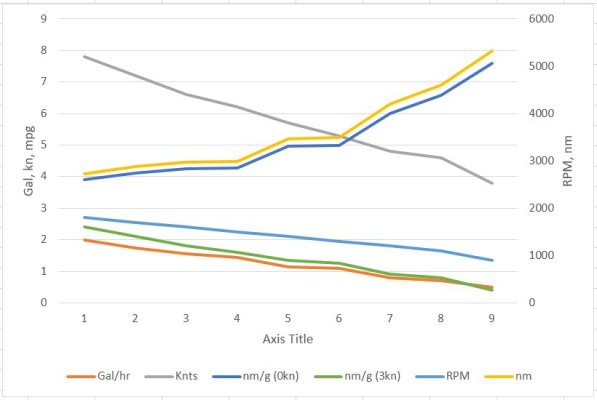diver dave
Guru
- Joined
- Jan 13, 2017
- Messages
- 2,570
- Location
- United States
- Vessel Name
- Coquina
- Vessel Make
- Lagoon 380
Thanks to a recent post by a KK42 owner, we have the fuel burn data below. I've added a new column on the right.
current on the nose:
0 kts 3 kts
RPMs Gal/hr Kts nm nm/g nm/g
1,800 2 7.8 2,730 3.90 2.4
1,700 1.75 7.2 2,880 4.11 2.1
1,600 1.55 6.6 2,981 4.26 1.8
1,500 1.45 6.2 2,993 4.28 1.6
1,400 1.15 5.7 3,470 4.96 1.35
1,300 1.1 5.5 3,500 5.00 1.25
1,200 0.8 4.8 4,200 6.00 0.9
1,100 0.7 4.6 4,600 6.57 0.8
900 0.5 3.8 5,320 7.60 0.4
What you have is the scenario of, for instance, living on the coast in N FL and going to the islands fighting the gulfstream for a good distance. Let's say that is by choice, because you don't want to go down the ICW or hug the shoreline. Maybe you want to dolphin fish.
Anyway, you can see now the mileage goes up with increasing power. Not sure where this limits out, but I'm thinking perhaps at 2000 rpm or so.
Taken one step further, if you choose to ANGLE into the islands, with the GS on your stb quarter, then you might find the angle at which the mileage is virtually a constant, no matter the engine rpm!
sorry, a perfect formatting job is destroyed once posted.
current on the nose:
0 kts 3 kts
RPMs Gal/hr Kts nm nm/g nm/g
1,800 2 7.8 2,730 3.90 2.4
1,700 1.75 7.2 2,880 4.11 2.1
1,600 1.55 6.6 2,981 4.26 1.8
1,500 1.45 6.2 2,993 4.28 1.6
1,400 1.15 5.7 3,470 4.96 1.35
1,300 1.1 5.5 3,500 5.00 1.25
1,200 0.8 4.8 4,200 6.00 0.9
1,100 0.7 4.6 4,600 6.57 0.8
900 0.5 3.8 5,320 7.60 0.4
What you have is the scenario of, for instance, living on the coast in N FL and going to the islands fighting the gulfstream for a good distance. Let's say that is by choice, because you don't want to go down the ICW or hug the shoreline. Maybe you want to dolphin fish.
Anyway, you can see now the mileage goes up with increasing power. Not sure where this limits out, but I'm thinking perhaps at 2000 rpm or so.
Taken one step further, if you choose to ANGLE into the islands, with the GS on your stb quarter, then you might find the angle at which the mileage is virtually a constant, no matter the engine rpm!
sorry, a perfect formatting job is destroyed once posted.





